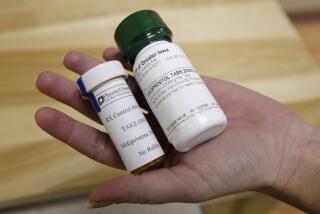For contraception, U.S. women increasingly turn to IUDs and implants
- Share via
IUDs and implants are safe, reliable, long-acting and reversible forms of birth control. Now there’s a new attribute to add to this list: increasingly popular.
A new report from the U.S. Centers for Disease Control and Prevention shows that American women are embracing these contraceptive devices. In the last decade, their use has increased nearly five-fold, with 7.2% of women ages 15 to 44 now relying on them to prevent pregnancy.
Even at that level, intrauterine devices and hormonal implants still have a ways to go to catch up with birth control pills, which are used by 28% of U.S. women of childbearing age. Another 16% of women depend on male condoms for contraception, according to the Guttmacher Institute.
But doctors are increasingly endorsing IUDs and implants as safe and effective ways to avoid pregnancy while still preserving the option of having children in the future. Once these devices are in place, they will do their job for up to 10 years without requiring women to do anything.
A clinical trial published last year in the New England Journal of Medicine found that hormone implants or copper IUDs were 100% effective in preventing unwanted pregnancies among teens. Hormone-releasing IUDs and hormone injections were nearly perfect, with only about 5 failures per 1,000 teen-years of use.
For the sake of comparison, users of birth control pills experienced about 57 failures per 1,000 teen-years of use during the clinical trial.
Today, IUDs account for the lion’s share long-acting, reversible contraceptives, or LARCs, the new CDC report says. Data from the most recent National Survey of Family Growth show that 6.4% of women used IUDs between 2011 and 2013, and another 0.8% used hormonal implants.
These forms of contraception are most popular among women between the ages of 25 to 34, with combined usage rates of 11.1% in the 2011-2013 period. That compares with 5% for women ages 15 to 24 and 5.3% for women ages 35 to 44, according to the report.
The CDC researchers also found that mothers were about four times more likely to use LARCs (11%) than women who were childless (2.8%). Still, the proportion of childless women using IUDs or implants was nearly 10 times higher in 2011-2013 than it had been in the years 2006 to 2010.
The researchers also noticed differences among racial and ethnic groups. Between 1988 and 1996, IUDs and implants were about equally unpopular with all women. In 2002, they were still used only rarely by African American and white women. But use among Latina women roughly doubled between 1995 and 2002 and held steady through 2010.
African American and white women caught up with Latinas in the 2006-2010 period. Then usage rates spiked for white and Latina women, rising nearly 130% by 2011-2013. Among African American women, the popularity of LARCs grew by a more modest 30%, according to the study.
One shortcoming of LARCs is that they do not prevent the spread of sexually transmitted infections, such as HIV, HPV, chlamydia and gonorrhea. That’s why health experts recommend using latex condoms, especially with new sexual partners.
The new report was published Tuesday by the CDC’s National Center for Health Statistics.
For more medical news, follow me on Twitter @LATkarenkaplan and “like” Los Angeles Times Science & Health on Facebook.







